
Schools- enterprises Cooperation
Brief Introduction of Fully Variable Hydraulic Valve System
发布日期:2016/11/24 发布人:管理员
Brief Introduction of Fully Variable Hydraulic Valve System
The Fully Variable Valve System (FVVS) can achieve continuous variable valve lift, valve opening duration and valve timing, which is of great significance for energy saving and emission reduction of engines. FVVS can control the amount of working fluid entering the cylinder by means of intake valve early closing (EIVC), thus canceling the throttle. This kind of unthrottled gasoline engine will greatly reduce the pumping loss and reduce the fuel consumption at medium and small loads by 10-15%. The fully variable valve system is matched with the supercharged intercooler, which can solve the problem of high deflagration and heat load after the gasoline engine is pressurized, achieve low temperature combustion under the premise of greatly increasing the average effective pressure, improve engine thermal efficiency and reduce harmful gas emissions. Therefore, FVVS technology has become one of the important development directions of new internal combustion engine technology.
Currently, the more advanced Fully Variable Valve System in foreign countries is the MultiAir (also known as UniAir) system jointly developed by Schaeffler and Fiat. The system was awarded the “2012 Automotive Supplier Outstanding Contribution Award” by the Automotive News of the United States. (2012 Automotive News PACE), the corresponding model was rated as the world's best new engine. After nearly ten years of exploration, the relevant technical personnel of Shandong University have developed a fully variable hydraulic valve system (referred to as SDFVVS system). Comparing with the MultiAir system, the SDFVVS system developed by Shandong University has obvious advantages in reliability and manufacturing cost and have completely independent intellectual property rights. The relevant information is explained as follows:
The MultiAir technology developed by Schaeffler uses a camshaft-driven electromagnetic valve mechanism to control the valve movement law through the combination of the camshaft and the solenoid valve. Figure 1 shows a schematic view of the structure of the valve train.

Fig. 1 MultiAir System Architecture
The working principle of the system is as follows: by the cam to promote the hydraulic piston, the hydraulic piston is connected to the driving piston through the hydraulic chamber, and the hydraulic chamber is controlled by a switching electromagnetic valve. When the electromagnetic valve is completely closed, the hydraulic piston drives the driving piston through the liquid pressure to pass the pressure of the cam to the valve. At this time, the intake valve is completely controlled by the cam and is in the open state. When the electromagnetic valve is fully open, the liquid pressure cannot transfer the driving force, the hydraulic piston cannot drive the driving piston, and the intake valve is no longer controlled by the cam and is in the fall or close state. By controlling the opening and closing time of electromagnetic valve, various valve motion laws can be achieved, and the function of fully variable valve system can be achieved.
The SDFVVS system developed by Shandong University is also a fully variable hydraulic valve system driven by a gas-filled cam. The mechanism drives the intake valve to open by a hydraulic valve drive mechanism disposed between the valve cam and the intake valve, and the oil control valve is used to release the oil pressure in the hydraulic system to close the intake valve. The seating cushion mechanism which is disposed between the piston sleeve and the hydraulic piston controls the valve seating speed to achieve stable seating of the valve.
The SDFVVS system works in the same way as Schaeffler's UniAir technology, and is an electronically controlled fully variable hydraulic valve system. However, its core technology has essential differences. MultiAir technology uses high-frequency electromagnetic valves (above 200Hz) as the oil control switch of the hydraulic system; and the SDFVVS system developed by Shandong University uses the oil control valve as the oil control switch of the hydraulic system. The oil control valve is an adjustable outlet rotor valve, which not only reduces the manufacturing cost, but also overcomes the low frequency response characteristics of the high frequency electromagnetic valve. It laid the foundation for the commercial development of high-frequency electromagnetic valve systems. SDFVVS has the following advantages:
(1) Advanced technology. The SDFVVS system has the technical advantages of high transient response, reliable operation and compact structure. Compared with the MultiAir system, the SDFVVS system developed by Shandong University. has successfully replaced the high-frequency electromagnetic valve with a mechanical oil control valve. Therefore, it has the advantages of high transient response characteristics and reliable operation, and has completely reached the international advanced level.
(2) Low cost. The Schaeffler MultiAir system requires a high-frequency electromagnetic valve (about $1,000) per cylinder and a gasoline engine that costs around $4,000. The cost of the SDFVVS system is around RMB 1,000-2000 (USD150-300), which is less than one-tenth of the cost of MultiAir system.
(3) Industrial policy. The SDFVVS system can achieve continuous variable valve lift, valve opening duration and valve timing, which is of great significance for energy saving and emission reduction of automobile engines. This technology is in line with the national industrial policy and is supported as green industry by the national science and technology development.
(4) Intellectual property rights. The SDFVVS system has completely independent intellectual property rights. Two invention patents (ZL200610042070.9., ZL201310296611.0.) have been authorized and are applying for foreign invention patents through the PCT route. Enterprises can protect the legitimate rights and interests created by the development of new technology products within the scope of intellectual property laws.
At present, the SDFVVS system has been running for more than 300 hours on the SD2100 diesel engine. SDFVVS has achieved remarkable results in improving fuel economy and power, achieving low-temperature combustion and reducing emissions. As shown in Fig. 4a, under the premise that the maximum combustion pressure remains basically stable, after the SDFVVS is matched with the supercharging, the average effective pressure is increased by 21.5% (the dynamometer is in a fat trend); the cylinder pressure is shown in Fig. 4b in the heat release rate curve, the proportion of premixed combustion after SDFVVS matching boosting is increased, the proportion of diffusion combustion is reduced, the oil and gas mixing is more uniform, and the combustion temperature is lowered, so that fuel consumption and PM emissions are also significantly improved.


(a) P-V Diagram (b) Cylinder Pressure and Heat Release Rate
Fig. 4 Comparison of Combustion Process between Original Machine and Prototype with the same Air Intake
The SDFVVS system has also completed the test measurement and ignition operation of the valve motion law on the Foton BJ486EQ gasoline engine. Fig. 5 shows the measured valve lift at 4000 r/min of the SDFVVS system. Fig. 6 shows the low-pressure diagram of the unthrottled gasoline engine developed by the SDFVVS system at 2000r/min and 30N.m. It can be seen that compared with the original machine, the pumping loss of the unthrottled gasoline engine is significantly improved, and the pumping loss is reduced by up to 78%.

Fig. 5 Measurement of Valve Lift for 4000r/min Gasoline Engine

Fig. 6 Comparison of Low Pressure Indicator Diagram of Original Engine and Unthrottled Gasoline Engine
By improving the pumping loss and combustion performance of the unthrottled gasoline engine, the fuel economy performance of the BJ486EQ gasoline engine under medium and small loads is significantly improved. Fig. 7 shows the load characteristic curve of the unthrottled gasoline engine under medium and small load conditions. Compared with the conventional gasoline engine, the fuel consumption rate of the unthrottled gasoline engine is reduced by 6.2%-12.5%.
Fig. 8 is the overall structural layout of the SDFVVS, and Fig. 8 is the actual installed photo of the SDFVVS in the BJ486EQ cylinder head. It can be seen that the SDFVVS system has a compact structure and maintains the versatility with the original machine to the utmost extent, and thus initially has the conditions for commercial production.

Fig. 7 Comparison of Load Characteristics between Original Engine and Unthrottled Gasoline Engine.